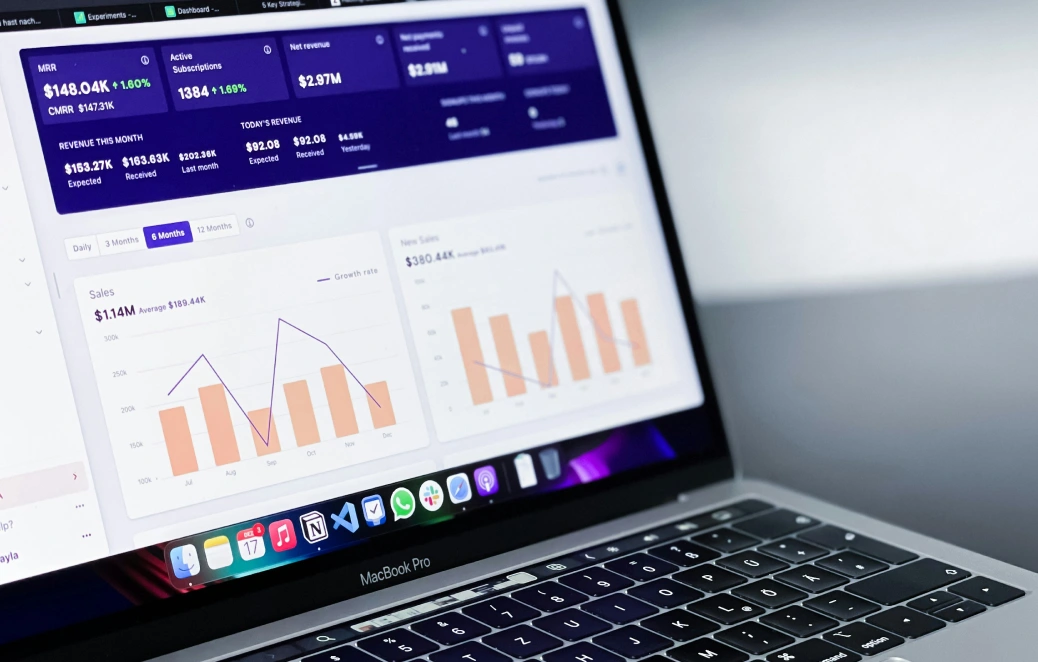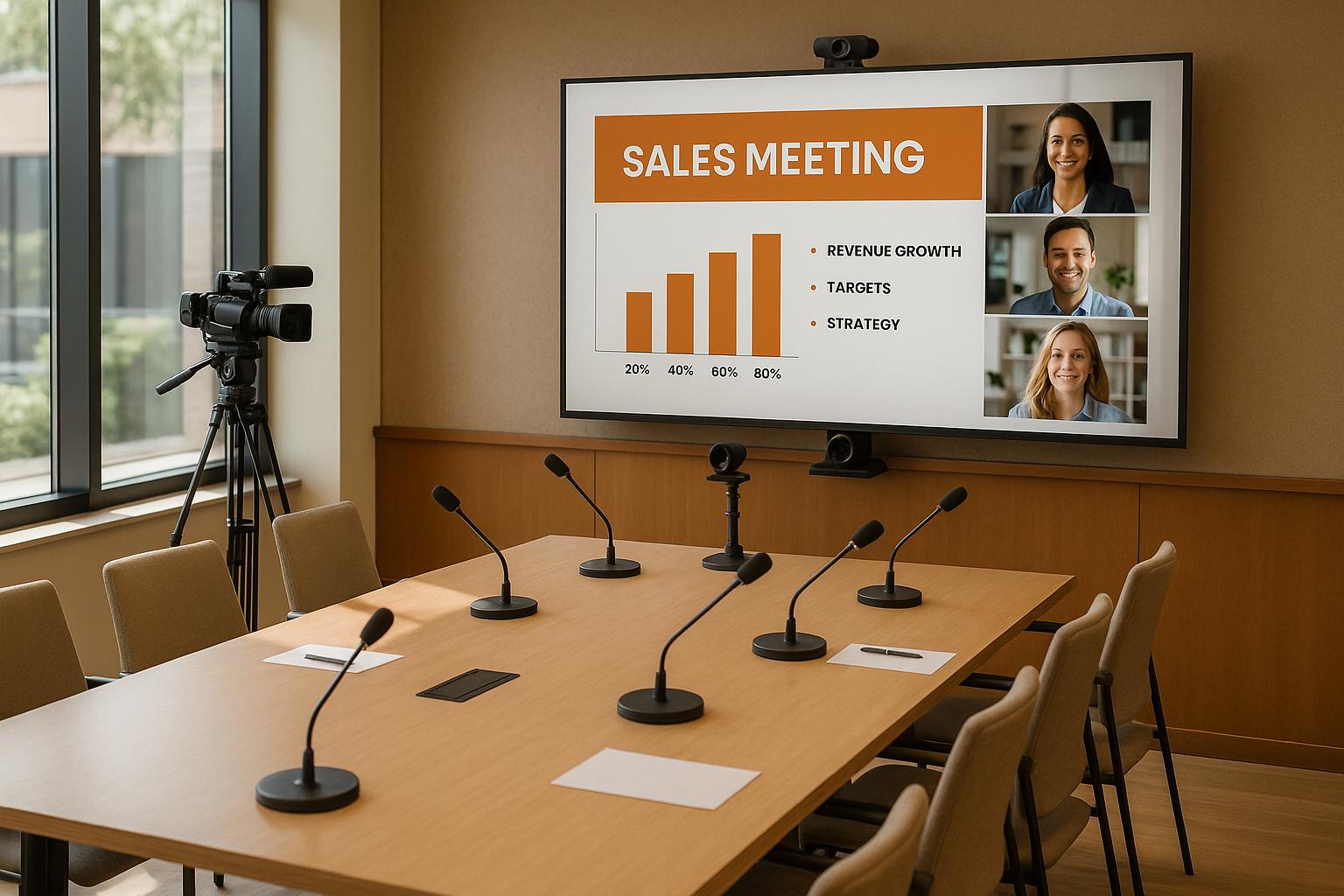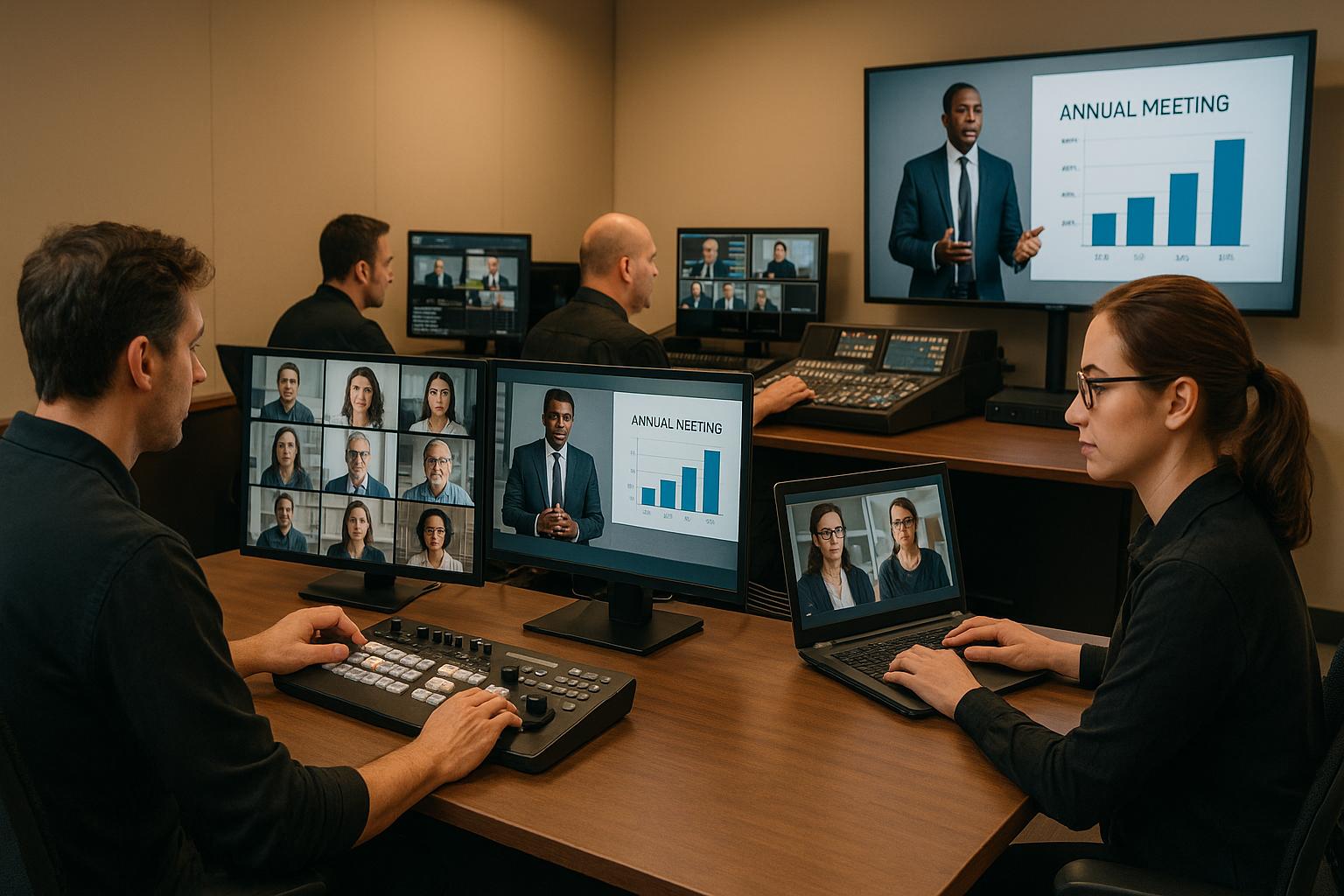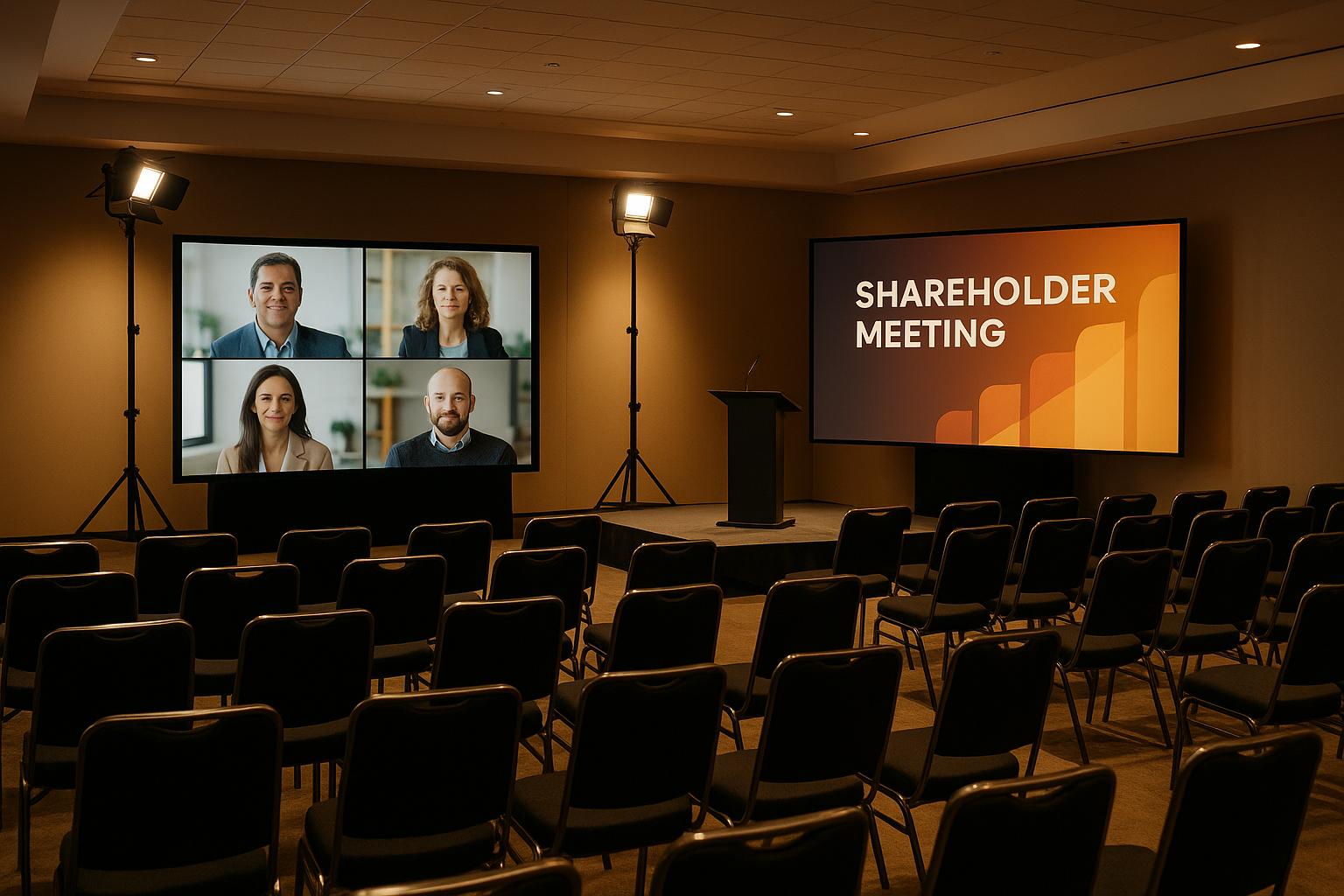10 Creative Ways To Boost Engagement At A Leadership Conference

Chief Executive Officer
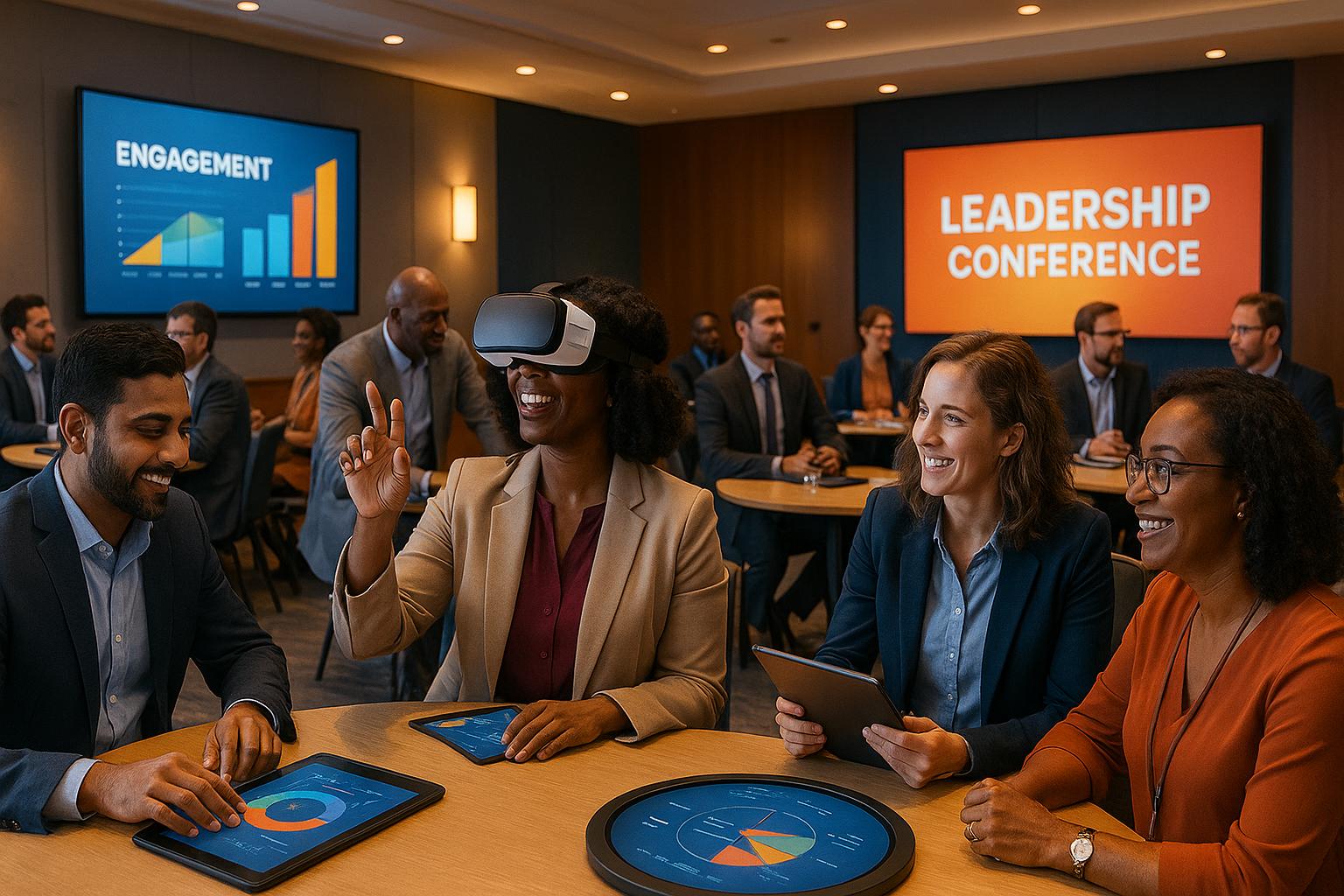
Leadership conferences need to do more than just deliver information - they must actively engage attendees, especially executives who value their time. Here are 10 ways to make these events more interactive and impactful:
- Interactive Technologies: Use tools like live polling, Q&A platforms, and real-time sentiment analysis to keep audiences engaged.
- Gamification: Add team challenges or business simulations to encourage collaboration and competition.
- Personalized Content: Tailor sessions and materials to individual attendee interests and leadership challenges.
- Immersive AV Experiences: Leverage advanced visuals, lighting, and sound to create dynamic environments.
- Guided Networking: Organize structured activities like roundtables or speed networking to facilitate meaningful connections.
- Recognition Moments: Celebrate leadership achievements with tailored awards and peer nominations.
- Hybrid Platforms: Ensure virtual and in-person attendees can participate equally through advanced digital tools.
- Interactive Panels: Host executive panels and AMA sessions to encourage open dialogue and practical takeaways.
- Thematic Concepts: Align the event around a central theme that addresses leadership priorities.
- Post-Event Analytics: Use data to assess engagement, refine future events, and measure success.
These strategies combine technology, networking, and tailored content to create conferences that resonate with leadership audiences.
10 Quick IN-PERSON Group Exercises For Engagement
1. Use Interactive Event Technologies with Real-Time Engagement Tools
Leadership conferences are no place for outdated tools. Executives expect cutting-edge technology that enhances their experience and keeps them engaged. Real-time engagement tools are game-changers, turning passive audiences into active participants.
Why This Matters for Leadership Audiences
Executives thrive on instant access to information and the ability to control how they interact with content. Tools like interactive polling platforms let them share strategic thoughts anonymously during sessions, while live Q&A features allow them to ask detailed questions without interrupting the speaker. Even word cloud generators come into play, visualizing collective feedback on leadership challenges and helping presenters quickly identify what resonates with the audience.
These tools don’t just enhance presentations - they foster collaboration. Digital whiteboards and brainstorming apps let executives contribute ideas in real time, combining their expertise to solve problems during breakout sessions. The visual, data-driven nature of these tools aligns perfectly with how leaders typically approach high-level decision-making.
Boosting Interaction and Engagement
Real-time sentiment analysis tools gauge audience interest on the spot, offering immediate feedback to speakers. Interactive timeline features, on the other hand, allow attendees to map their organization’s progress alongside industry trends, creating personalized and relevant learning experiences.
Between sessions, push notifications keep attendees informed with tailored content, networking opportunities, and updates. Features like digital business card exchanges, meeting schedulers, and private messaging systems make it easier for executives to connect with peers in meaningful ways.
Flexibility Across Event Formats
What’s great about these tools is their ability to adapt to any format - whether in-person, hybrid, or virtual. Cloud-based platforms ensure that everyone, regardless of location, has access to the same polling, Q&A, and collaboration features. This means virtual attendees can participate just as fully as those in the room.
For networking, breakout room technology offers structured discussions by randomly pairing participants, mimicking the organic connections often found at in-person events. Virtual attendees can also share screens to present ideas or use simultaneous translation tools, making these events more inclusive for global teams.
Practical Applications for Leadership Events
These technologies don’t just stop at the conference - they integrate seamlessly with existing corporate systems. API integrations allow attendees to sync contacts and insights directly into their company’s CRM or collaboration tools. Custom mobile apps, branded for the company, can also add tailored functionality, ensuring a cohesive experience that extends beyond the event.
Event organizers benefit too. Real-time analytics dashboards track engagement, measure content effectiveness, and summarize attendee feedback. Automated post-event reports help refine future conferences, ensuring continuous improvement.
Corporate Optics brings these engagement technologies to life, letting leaders focus on what matters - learning, collaborating, and building connections.
2. Add Gamification and Leadership Team Challenges
Building on the interactive technologies discussed earlier, gamification takes engagement to the next level by introducing competitive dynamics that resonate with leadership audiences. This approach transforms traditional conferences into exciting, hands-on experiences that tap into the natural competitiveness of leaders.
Why Gamification Appeals to Leaders
Executives often thrive in competitive environments, making gamified elements a natural fit. Simulation games provide a safe space for strategic thinking, allowing participants to experiment with decisions and outcomes without real-world risks. Team-based competitions, on the other hand, encourage collaboration - an essential skill for C-suite professionals - while reinforcing strategies that promote leadership growth.
Point-based systems are particularly effective when they’re tied to meaningful outcomes. Instead of relying on superficial rewards like badges or leaderboards, the focus shifts to strategic decision-making scenarios. Here, participants can earn recognition for innovative ideas or exceptional teamwork. This approach respects the sophistication of executive audiences while keeping them engaged through friendly competition.
For example, business case competitions during conferences bring leaders together to solve real-world challenges. Teams are often composed of individuals from different industries, blending diverse perspectives to tackle complex problems. Not only does this foster deeper engagement, but it also builds lasting professional connections.
Boosting Interaction and Engagement
Gamified team challenges break down traditional hierarchies, encouraging open interaction among peers. Activities like escape room-style problem-solving - tailored for business scenarios - push participants to communicate effectively, delegate tasks, and perform under pressure. These are all critical leadership skills.
Another popular option is digital scavenger hunts, which encourage attendees to explore conference sessions, interact with sponsors, and complete networking tasks. Participants earn points by attending workshops, engaging with exhibitors, or meeting specific objectives. This ensures attendees stay active and involved while still focusing on key learning goals.
Role-playing simulations also create dynamic conversations and challenge participants to think critically. By defending their strategies and decisions in real-time, leaders gain a deeper understanding of complex business issues and sharpen their problem-solving abilities.
Flexibility Across Formats: In-Person, Hybrid, and Virtual
One of the best things about gamification is its adaptability. Whether the event is in-person, hybrid, or fully virtual, these tools can be seamlessly integrated. For example, virtual reality team challenges are perfect for remote participants, while augmented reality features can enhance the experience for those attending in person. Cloud-based gaming platforms ensure everyone - regardless of location - has access to the same features.
Hybrid events, in particular, benefit from synchronized challenges that bring together virtual and in-person teams. Digital collaboration tools allow remote attendees to actively participate, while live streaming ensures they feel just as immersed in the competitive energy as those on-site.
Mobile-first gaming platforms are another versatile option. These allow participants to engage with challenges before, during, and even after the event, extending the excitement and impact of gamification well beyond the conference itself.
Leveraging Technology for a Seamless Experience
The practical application of technology is key to making gamification work. For instance, API integrations can link gamification platforms with existing conference management systems, enabling real-time tracking of participation and automatic leaderboard updates.
Artificial intelligence also plays a role by creating balanced teams. By analyzing attendee profiles - such as industry experience and leadership style - AI ensures teams are well-matched. Machine learning can even adjust the difficulty of challenges in real-time based on team performance, keeping everyone engaged without overwhelming them.
Corporate Optics uses these technologies to design gamified experiences that align with leadership development goals. The result? Competitive elements that enhance the learning process rather than distract from it, ensuring participants leave with both valuable insights and stronger connections.
3. Build Personalized Content Experiences for Attendees
Personalized content experiences are redefining how conferences engage their audiences. By tailoring every aspect of the attendee journey to individual preferences and specific challenges, this approach creates a more meaningful and impactful experience.
Relevance to Leadership-Focused Audiences
For leadership professionals, personalization is more than a nice-to-have - it's essential. Leaders face unique challenges depending on their industry, the size of their organization, and their career stage. A Fortune 500 CEO, for instance, has vastly different priorities compared to a nonprofit director. Personalized content experiences address these nuances by offering customized learning paths that align with each attendee's specific leadership context.
Imagine an executive navigating digital transformation: they could be directed toward workshops on emerging technologies or case studies showcasing successful tech integration. Meanwhile, a leader managing remote teams might be guided to sessions on virtual leadership strategies. This ensures that every session feels relevant and valuable.
Personalization doesn’t stop at content topics - it extends to how the content is delivered. Some leaders thrive on data-driven case studies, while others prefer interactive discussions or visual storytelling. Personalization engines can adapt in real-time, tailoring the format based on engagement and feedback, ensuring a truly individualized experience.
Generic presentations often fail to resonate with sophisticated leadership audiences. By customizing content to meet their specific needs, conferences not only respect attendees' time but also provide actionable insights that leaders can apply immediately.
Enhancing Interaction and Engagement
Personalized content naturally fosters engagement by making every session feel directly applicable to attendees. Smart matching algorithms can pair participants with similar challenges or complementary expertise, encouraging meaningful conversations during breakout sessions and networking opportunities.
Real-time adjustments keep energy levels high. If analytics reveal that certain audience segments are disengaging during a session, the system can introduce interactive polls, Q&A opportunities, or small group discussions tailored to re-engage those attendees. This dynamic approach prevents the typical mid-session lulls that often occur at traditional events.
Between sessions, micro-learning modules provide bite-sized, personalized content to reinforce key insights. These quick, targeted pieces keep attendees engaged and prevent information overload, ensuring that important takeaways stick.
Interactive content paths also allow attendees to explore topics at their own pace. Instead of passively absorbing information, they can dive deeper into areas that resonate with their unique leadership challenges. This self-directed approach not only boosts engagement but also improves retention of key concepts.
Scalability for In-Person, Hybrid, or Virtual Formats
One of the greatest strengths of personalized content systems is their ability to adapt seamlessly across different event formats - whether in-person, virtual, or hybrid.
Virtual attendees can benefit from tailored dashboards featuring personalized content, interactive networking opportunities, and real-time guidance through AI-powered chatbots. These chatbots help participants navigate sessions and connect with peers who share similar interests or challenges.
For hybrid events, personalization bridges the gap between physical and digital experiences. In-person attendees might receive location-based content suggestions via mobile apps, while virtual participants get equivalent recommendations for online sessions. This ensures that everyone, regardless of how they’re attending, enjoys a consistent and tailored experience.
Asynchronous content delivery takes personalization even further. After the live event ends, attendees can access customized follow-up materials, continue their learning paths, and maintain connections through personalized networking suggestions. This extends the value of the conference long after it’s over.
Practical Use of Technology or Programming
Personalized content experiences rely heavily on smart data collection and analysis. From registration details to behavioral tracking, every piece of data helps refine recommendations to better meet attendees’ needs.
Real-time analytics dashboards allow organizers to monitor how well personalization efforts are working and make quick adjustments if needed. Tools like heat mapping technology track which content resonates most with different audience segments, offering valuable insights for future events.
Companies like Corporate Optics are already leveraging these technologies to analyze attendee behavior and deliver precise recommendations. Even communication styles can be personalized using natural language processing, ensuring every interaction feels relevant and tailored to each leadership professional.
4. Design Immersive Scenic and Audiovisual Experiences
Modern leadership conferences thrive on immersive audiovisual (AV) experiences that transform venues into dynamic spaces. These setups use cutting-edge technology and visual storytelling to amplify key messages and create memorable environments.
Relevance to Leadership-Focused Audiences
High-level executives expect a polished, professional atmosphere that reflects their standards. Features like dynamic lighting, large-scale displays, and carefully crafted scenic designs bring leadership themes to life. For instance, Corporate Optics specializes in creating environments that visually reinforce leadership concepts and signal a commitment to quality.
Strategic visual elements also make complex ideas easier to grasp. Imagine using lighting transitions and large-scale video displays to mirror an organization's transformation journey. These visual cues not only enhance understanding but also establish credibility and professionalism, elevating the overall experience.
Promoting Interaction and Engagement
Immersive environments naturally encourage participation. Intelligent lighting can guide attention, while tools like interactive projection mapping and spatial audio systems add depth to presentations without overwhelming attendees.
For example, projection mapping can adapt in real-time to audience interactions. When a CEO discusses market expansion, a live map could highlight regions as the conversation progresses, ensuring the audience stays visually engaged with the topic. Similarly, spatial audio can create a more immersive atmosphere, influencing how attendees connect with both the content and each other.
Scalability for In-Person, Hybrid, or Virtual Formats
Advanced AV systems ensure these immersive experiences work seamlessly across different event formats. Whether in-person, hybrid, or fully virtual, the technology adapts to deliver consistent quality and engagement.
Virtual attendees can connect through synchronized platforms that mirror the in-person experience. Interactive tools like polling systems or live displays enable simultaneous participation from both physical and remote audiences. Fully virtual events can even feature 3D environments that replicate the visual impact of physical spaces while adding unique elements like virtual networking lounges, customizable viewing angles, and integrated collaboration features. These tools create a unified experience, regardless of where attendees are located.
Practical Use of Technology and Programming
The integration of advanced technologies ensures conferences run smoothly and maintain a professional flow. Automated systems sync lighting, audio, video, and interactive elements, allowing for seamless transitions between sessions. This eliminates the need for manual adjustments during multi-speaker events, keeping everything on track.
Corporate Optics employs tools like AI-powered production systems and LED wall technology to deliver stunning visuals and flawless synchronization. These LED walls provide exceptional brightness for well-lit venues, scale effortlessly for different room sizes, and allow real-time content updates.
Speakers also benefit from intuitive control interfaces. Tablet-based systems let presenters manage slides, adjust lighting, play videos, and activate audience engagement tools - all without needing technical assistance. This not only ensures a smooth presentation but also boosts speaker confidence, creating a more polished and engaging experience for everyone involved.
5. Host Guided Networking Activities and Peer Roundtables
Guided networking activities take leadership conferences to the next level by creating opportunities for direct, meaningful collaboration. While immersive technologies and gamified experiences draw people in, these structured interactions focus on building human connections. Instead of just listening to speakers, participants actively engage with peers, transforming the event into a hub for dynamic collaboration.
Why This Matters for Leadership Audiences
Senior executives don’t just want to meet people - they want to meet the right people. They value networking that delivers actionable insights and solutions to their most pressing challenges. Peer roundtables are a prime example, bringing together leaders who face similar issues for focused, productive discussions. Whether the topic is digital transformation, retaining talent, or managing crises, these sessions ensure conversations are relevant and impactful.
Executives appreciate formats that prioritize meaningful dialogue over small talk. Activities like speed networking, mentorship circles, or industry-specific breakout groups provide clear structures that encourage productive conversations. Corporate Optics designs these sessions to meet the high standards executives expect, while still fostering authentic connections.
The key to success? Relevance and exclusivity. Leaders are more likely to engage when they know they’re speaking with peers who truly understand their challenges. Organizing sessions by factors like company size, industry, or leadership role ensures discussions stay targeted and valuable.
Encouraging Interaction and Engagement
Guided networking is designed to break down barriers and get people talking. Structured formats like rotating roundtable discussions keep energy levels up by moving participants between groups every 15-20 minutes. This constant flow of fresh perspectives prevents conversations from becoming repetitive or stagnant.
Problem-solving workshops take things a step further by giving participants real challenges to solve as a group. These might include analyzing case studies, brainstorming innovative solutions, or tackling strategic planning exercises. The shared experience of working through problems together creates connections that last long after the event ends.
Interactive tools can also boost engagement. For example, live polls during roundtables let facilitators gauge group sentiment and adjust discussions in real time. Digital collaboration tools make it easy for participants to share contact information, capture takeaways, and continue conversations after the session.
Adapting for In-Person, Hybrid, or Virtual Formats
These networking activities are flexible enough to work across all types of events, thanks to technology-driven solutions. Virtual breakout rooms recreate the intimacy of in-person discussions, while hybrid formats ensure both on-site and remote participants can contribute equally.
Digital networking platforms simplify pre-event matchmaking by grouping participants based on their profiles, interests, and goals. This ensures that whether the event is virtual, in-person, or hybrid, attendees are paired with the right people for meaningful discussions.
For hybrid events, coordinated sessions ensure a seamless experience for everyone. Virtual networking lounges provide informal spaces for continued conversations, while scheduled one-on-one video meetings replicate the organic connections that naturally occur at in-person events.
Leveraging Technology for Better Networking
Technology plays a big role in making these activities effective and efficient. Scheduling systems match participants based on factors like industry, company size, and networking goals, ensuring optimal group dynamics.
QR codes take the hassle out of exchanging contact information. Participants can instantly share details, schedule follow-ups, and access shared resources without dealing with business cards or manual data entry. Corporate Optics integrates these tools to ensure smooth transitions between networking sessions and the main event.
Real-time feedback tools like live polls and surveys help facilitators fine-tune activities on the spot. If a discussion is thriving, they can extend it; if it’s not working, they can pivot quickly. This data also helps improve future events by tailoring activities to participant preferences.
Finally, automated follow-ups ensure connections don’t end when the event does. By combining structured programming with smart technology, these networking activities deliver lasting value, creating meaningful relationships that extend well beyond the conference.
sbb-itb-ae35a94
6. Include Recognition and Leadership Awards Moments
Recognition ceremonies can turn conferences into celebrations that honor achievements and inspire excellence. These moments leave a lasting impression on attendees, creating highlights they’ll remember long after the event ends. Unlike traditional award shows, leadership recognition segments emphasize peer-to-peer appreciation and showcase real business impact. This approach not only energizes the event but also aligns with the values and priorities of executive audiences.
Relevance to Leadership-Focused Audiences
For senior executives, recognition moments are especially meaningful because they highlight achievement and growth - values that resonate deeply with leaders. Leadership awards moments focus on celebrating excellence and results-driven performance, often through real success stories from their peers. These stories don’t just inspire; they feel relatable and attainable.
To make these moments even more impactful, tailor recognition categories to address challenges leaders face. For example, awards for digital transformation, crisis management, or innovative team building are highly relevant because they reflect real-world leadership hurdles. When executives see their peers being recognized for overcoming similar challenges, it sparks both inspiration and practical takeaways.
Industry-specific recognition adds another layer of connection. For instance, technology leaders might appreciate seeing how other CTOs tackled complex problems, while HR executives value awards for culture transformation. By targeting recognition to specific roles and responsibilities, you ensure that every attendee finds these moments meaningful.
Ability to Promote Interaction and Engagement
Recognition moments naturally invite audience participation through activities like voting, nominations, and live reactions. Incorporating live polling or peer nominations creates excitement and buzz even before the event begins. For categories such as "Leadership Mentor of the Year" or "Most Innovative Problem Solver", peer recognition carries extra significance, making the process feel more personal and engaging.
The storytelling aspect of these moments also plays a big role in boosting engagement. Instead of simply announcing winners, include short video testimonials from team members, customers, or colleagues who have directly benefited from the honoree's work. These personal stories create emotional connections, making the recognition feel authentic and keeping the audience invested in the outcome.
Scalability for In-Person, Hybrid, or Virtual Formats
Recognition ceremonies can be adapted seamlessly across in-person, hybrid, and virtual formats. Features like live voting, digital recognition walls, and breakout celebration rooms allow all attendees to actively participate, no matter where they are. For hybrid events, digital recognition walls are particularly effective - they can display nominee profiles, achievements, and real-time voting results that both virtual and in-person audiences can access simultaneously. This keeps recognition moments visible throughout the event, not just during the ceremony.
In virtual-only events, breakout celebration rooms can recreate the personal touch of in-person gatherings. These smaller spaces allow attendees to congratulate winners directly and engage in meaningful conversations about their achievements. This approach ensures recognition remains an integral and unifying part of the event, regardless of the format.
Practical Use of Technology or Programming
Technology can amplify the impact of recognition moments, both during and after the event. Automated nomination systems simplify the process by collecting submissions, supporting documents, and endorsements all in one place, making it easier to manage and review nominees.
Real-time voting tools turn recognition into an interactive experience. Attendees can use mobile apps or web platforms to cast votes, view live results, and feel directly involved in the recognition process. These tools work well for both formal awards and informal peer recognitions, adding an extra layer of engagement.
Digital displays allow attendees to dive deeper into the stories behind the awards. Platforms like Corporate Optics use these technologies to showcase achievements in greater detail, keeping the momentum of recognition alive beyond the event itself.
Additionally, technology enables post-event sharing, automatically generating social media posts, press releases, and internal communications. This extends the reach of recognition moments, amplifying their impact across professional networks and ensuring they resonate long after the event concludes.
7. Use Hybrid and Virtual Engagement Platforms
Hybrid and virtual platforms are reshaping leadership conferences by blending the energy of in-person events with the accessibility of digital tools. They break down geographical barriers while keeping the experience engaging and interactive. This approach not only expands the audience reach but also preserves the personal connections that executives value.
Why Leadership Audiences Benefit
Senior executives often juggle demanding schedules, and hybrid platforms provide the flexibility they need to participate meaningfully. Virtual attendance doesn't have to mean passively watching from the sidelines. Today’s platforms offer interactive features that make virtual experiences just as engaging as being there in person.
Networking is a big draw for leadership-focused events, and these platforms excel at creating meaningful connections. Features like virtual breakout rooms and AI-powered matchmaking bring executives together for focused, one-on-one conversations - eliminating the randomness of traditional networking.
The global reach of hybrid platforms is another game-changer. Leadership teams from multinational companies can now come together in a single event, with C-suite executives contributing insights from across continents. This diversity of perspectives enriches discussions, especially for leaders navigating global markets or managing cross-border teams.
Boosting Interaction and Engagement
Modern platforms go beyond simple video streaming. They include tools like real-time polls, live Q&A sessions, and chat features that encourage active participation from both virtual and in-person attendees. These tools help bridge the gap between physical and digital experiences, ensuring everyone feels equally involved.
Interactive elements like gamification and collaborative workspaces keep energy levels high. Features such as leaderboards or team challenges encourage participation while fostering problem-solving and collaboration. Leadership teams can even work on strategic exercises or case studies, with the ability to save and share their work after the event, extending the value of the conference.
Adapting to Different Formats
Today’s platforms are built to scale, making it easy to switch between in-person, hybrid, or fully virtual formats without losing momentum. This flexibility is crucial for leadership conferences, which often feature high-profile speakers with unpredictable schedules.
Breakout sessions are a great example of this adaptability. Virtual attendees can join themed discussions, while in-person participants can contribute seamlessly through mobile apps or digital workspaces. This integration creates a unified experience where the distinction between virtual and physical participation fades away.
Content delivery also adjusts to fit the audience. In-person attendees might receive physical handouts, while virtual participants access interactive digital materials with features like embedded videos and clickable links. This ensures everyone gets the same level of value, no matter how they attend.
Leveraging Technology for Better Outcomes
Advanced technology plays a key role in making these platforms effective. AI-powered analytics track engagement in real time, giving organizers the data they need to tweak content or pacing on the spot. This ensures that the event stays relevant and engaging throughout.
Integration is another strength. These platforms can connect with tools companies already use, like CRM systems, learning management platforms, or internal communication tools. This makes it easier to incorporate conference insights into everyday business operations.
A mobile-first design ensures busy executives can join from any device, whether they're in the office, on the road, or at home. Features like push notifications, calendar syncing, and offline access keep them connected, even during hectic schedules.
Corporate Optics uses these advanced platforms to create cohesive experiences that work equally well for virtual and in-person participants. By combining technology with a focus on meaningful connections, they deliver insights that leaders can put into action right away. This thoughtful use of technology sets the stage for smarter, more effective conference solutions.
8. Organize Interactive Executive Panels and AMA Sessions
Interactive executive panels and Ask Me Anything (AMA) sessions shift the focus from one-way presentations to lively, two-way conversations that truly engage leadership audiences. These formats break down the traditional speaker-attendee divide, encouraging open dialogue and meaningful knowledge-sharing - something executives rarely experience in their day-to-day routines.
Why These Formats Resonate with Leaders
Executives are always looking for actionable insights from others who have faced similar hurdles. Interactive panels provide a platform for leaders to dive into topics directly relevant to their organizations. The conversational nature mirrors the strategic discussions they’re accustomed to in boardrooms, making the content immediately relatable and applicable.
These panels are especially impactful when they tackle real-world challenges. Instead of sticking to abstract theories, they explore how other leaders have navigated specific situations like digital transformation, crisis management, or major organizational changes. This peer-to-peer learning approach hits home because it’s rooted in firsthand experience, making it far more practical than generic advice.
AMA sessions bring another layer of value by letting attendees steer the conversation. Leaders can ask pressing questions about industry trends, seek advice on unique challenges, or learn from the successes (and missteps) of their peers. This tailored format recognizes that no two organizations are the same, and cookie-cutter solutions often fall flat. The result? A dynamic exchange of ideas that keeps everyone engaged and energized.
Boosting Interaction and Engagement
The secret to a great interactive panel lies in structured spontaneity - a balance between a planned framework and the freedom for unscripted moments. Moderators are essential here, guiding the conversation while leaving room for organic dialogue to flourish.
Audience participation is another game-changer. Real-time polls during panels can gauge sentiment or highlight areas of interest, while live Q&A submissions ensure that the most pressing questions get addressed. This instant feedback loop keeps both the panelists and the audience fully engaged.
To take it a step further, breakout discussions can follow the main panel. These smaller, focused group conversations allow attendees to dive deeper into specific topics and foster closer connections. Often, these intimate settings produce the most actionable insights and valuable networking opportunities.
Flexibility Across Event Formats
One of the best things about interactive panels is their adaptability - they work seamlessly across in-person, virtual, and hybrid events. In-person sessions benefit from the immediacy of face-to-face interaction, while virtual formats can expand participation by removing geographical barriers and enabling a more diverse mix of speakers and attendees.
Hybrid events combine the strengths of both. Remote participants can join as panelists or attendees, submitting questions through chat, engaging in polls, and even participating in breakout rooms alongside in-person attendees. This integration ensures high-quality interaction, no matter the format.
Virtual and hybrid formats also offer an asynchronous advantage. Sessions can be recorded for later viewing, and discussions can continue on dedicated online platforms or forums. This extended engagement keeps the conversation alive well beyond the event itself, ensuring that the insights gained don’t fade away once the session ends.
Leveraging Technology for a Better Experience
Modern event platforms come equipped with tools that can elevate the panel experience. For example, AI-powered question curation can analyze audience submissions in real-time, identifying recurring themes and prioritizing the most relevant questions. This ensures the discussion stays on track and addresses what attendees care about most.
Live sentiment analysis provides moderators with instant feedback. If engagement dips or confusion arises, they can adjust the conversation or ask panelists to clarify tricky points. This adaptability keeps the session flowing smoothly and maintains audience interest.
For a polished experience, multi-camera setups and professional-grade audio can create a broadcast-quality feel. Features like picture-in-picture displays that highlight audience reactions add an immersive touch, making both in-person and virtual attendees feel equally connected.
Companies like Corporate Optics excel at using these tools to create impactful sessions. By focusing on authentic conversations rather than scripted presentations, they ensure executives walk away with practical insights they can use immediately. The combination of thoughtful planning, flexible execution, and advanced technology makes these sessions not just engaging but also highly effective for driving business outcomes.
9. Develop Thematic Event Concepts Aligned with Leadership Goals
Crafting a theme that resonates with a leadership audience can transform a conference into something far more impactful. When every aspect - keynotes, workshops, even coffee breaks - ties back to core leadership priorities, it creates an immersive experience. This approach not only keeps attendees engaged but also ensures they leave with actionable insights they can put into practice immediately. A strong theme naturally supports networking and personalized content, building on earlier strategies for driving engagement.
Relevance to Leadership-Focused Audiences
Leadership events thrive when they address the real challenges and goals leaders face. A thoughtful theme provides a unifying thread that connects every session to practical, leadership-oriented scenarios. Instead of broad business topics, themes should focus on areas like organizational resilience, digital transformation, or fostering high-performance teams.
For example, a theme like "Leading Through Uncertainty" could include crisis simulations, scenario planning, and discussions on navigating market volatility. Similarly, "The Future-Ready Leader" might explore emerging technologies, workforce changes, and sustainable practices. These themes are effective because they go beyond theory, offering frameworks leaders can adapt to their unique challenges.
The best themes also consider the diverse industries and backgrounds represented at leadership events. A concept like "Adaptive Leadership in a Connected World" can appeal to executives from fields as varied as healthcare, tech, manufacturing, and finance. This ensures the content remains relevant across the board, while also encouraging cross-industry learning.
Encouraging Interaction and Engagement
A well-executed theme fosters deeper conversations and stronger connections throughout the event. When sessions are tied to a central concept, attendees can build on earlier discussions, reference key points from prior presentations, and develop more nuanced insights as the event progresses.
Interactive activities become especially meaningful when they align with the theme. For example, a "Collaborative Leadership" theme might include team-based challenges, cross-functional working groups, or collaborative decision-making exercises. These activities feel natural and reinforce the event's core message about teamwork and shared success.
Storytelling also thrives under a strong theme. Leaders can share personal experiences that tie into the central idea, creating a narrative thread that runs through the event. Attendees start connecting the dots between speakers’ stories, uncovering patterns and practical takeaways that might otherwise go unnoticed.
Even informal moments, like coffee breaks, benefit from a thematic focus. Conversations naturally revolve around the theme, networking becomes more purposeful, and attendees can easily identify others who share similar challenges or goals.
Scalability for In-Person, Hybrid, or Virtual Formats
A strong theme works across all event formats - whether in-person, virtual, or hybrid - because it’s grounded in content and experience rather than logistics. It ensures consistency, whether participants are gathered in a conference hall or tuning in from home.
Virtual and hybrid formats, in particular, benefit from a clear theme. When sessions are clearly tied to a central idea, remote attendees can easily follow the flow and see how each component fits into the bigger picture.
Digital tools can amplify the theme in creative ways. Virtual backgrounds, branded interfaces, and themed breakout room names can make the experience more immersive. Features like live polls and chat discussions can weave the theme into every interaction, keeping participants engaged no matter where they are.
Leveraging Technology and Programming
Modern tech platforms make it easier than ever to integrate thematic elements into every aspect of the event. Custom mobile apps can offer theme-related resources, interactive features, and additional content that extends beyond the sessions themselves. Push notifications can highlight how different presentations connect to the overarching theme, helping attendees see the broader narrative.
Gamification is another way to reinforce the theme. For example, a leadership-focused conference might include challenges that mimic real-world decision-making scenarios, awarding points for participation in theme-related activities. This not only keeps attendees engaged but also reinforces key learning objectives.
Analytics and feedback tools can also be tailored to support the theme. Post-session surveys might ask how the content ties into the overall concept, while real-time polls can measure understanding of key ideas. These insights help organizers refine the program on the fly and inform planning for future events.
10. Use Post-Event Analytics to Drive Continuous Improvement
Post-event analytics are a game-changer for leadership conferences. They shed light on what worked, what didn’t, and what needs tweaking, giving organizers the tools to refine future events. For leadership-focused gatherings, where expectations are high and outcomes need to be measurable, this data becomes a crucial asset.
Why It Matters to Leadership Audiences
Leadership professionals - whether C-suite executives or mid-level managers - attend conferences with clear goals in mind. They want sessions that deliver actionable insights, networking opportunities that lead to meaningful connections, and content that respects their time. Post-event analytics help pinpoint exactly which sessions hit the mark, which networking activities were most effective, and which formats kept attendees engaged.
For example, data might show that senior executives prefer brief, impactful presentations, while mid-level managers gravitate toward hands-on workshops. Recognizing these preferences ensures future events cater to the distinct needs of these groups. Beyond attendance numbers, analytics can measure deeper outcomes, such as how often attendees implement strategies discussed during sessions or the strength of professional relationships formed at the event. This kind of insight ensures leadership conferences remain relevant and valuable.
Boosting Engagement and Interaction
Analytics don’t just measure attendance - they reveal what truly engages attendees. Organizers can identify which activities sparked the most participation and replicate those successes in future events. Real-time data, like social media activity or live polling results, highlights moments where audience interest peaked, which topics sparked the most conversations, and which content was shared widely within leadership circles.
Patterns in engagement can also guide event planning. For instance, data might show that attendees who participated in morning workshops were more energized during afternoon panels. Or perhaps certain speaker pairings led to higher satisfaction scores. These insights allow for smarter programming decisions that enhance the overall event experience.
Works Across All Event Formats
One of the best things about post-event analytics is their adaptability. Whether the conference is in-person, virtual, or hybrid, analytics tools provide consistent and valuable insights. Virtual events, for instance, offer rich data like session duration, chat participation, and poll responses. Hybrid events combine physical and digital engagement metrics, while in-person gatherings can leverage mobile apps and feedback tools to gather attendee input. No matter the format, the data paints a clear picture of what worked.
Leveraging Technology for Better Results
Modern analytics platforms simplify the process of turning raw data into actionable insights. Dashboards compile information from multiple sources, giving organizers a complete view of event performance. AI tools take it a step further by spotting trends, predicting high-engagement sessions, and even enabling real-time adjustments to keep participation levels high.
Post-event reporting tools also allow for tailored insights, catering to the needs of different stakeholders. Companies like Corporate Optics specialize in providing detailed analytics that help organizations assess the true impact of their leadership conferences. These insights drive ongoing improvements, ensuring events stay aligned with evolving audience expectations and industry trends.
Conclusion
Creating engaging leadership conferences goes beyond just booking great speakers. The real key lies in combining technology, strategic planning, and data insights to craft experiences that truly connect with leadership audiences.
Today’s leaders expect more than traditional presentations - they want interactive, hands-on experiences that keep them actively involved. Tools like live polling and Q&A platforms can increase attendee satisfaction by as much as 30%. Add elements like gamification, personalized content, immersive audiovisuals, and guided networking, and you’ve got an event where everyone feels engaged and valued. Hybrid platforms and moments of recognition further ensure attendees feel included, no matter how they participate.
The best events don’t stop there - they continuously improve by using post-event analytics. These insights help organizers see what worked and what didn’t, paving the way for even better results in the future. Events that embrace interactivity consistently report higher satisfaction and engagement levels compared to traditional setups.
At the heart of this approach is customization. Corporate Optics understands that no two leadership conferences are the same. By aligning their strategies with an organization’s specific goals and audience, they ensure every detail - from event planning and speaker support to live streaming and post-event analytics - is tailored to deliver measurable success. Their expertise makes it possible to create events that leave lasting impressions.
As technology advances and attendee expectations shift, leadership conferences must evolve to keep up. By embracing these creative engagement strategies, organizations can host events that not only inspire and connect leaders but also set new benchmarks for professional growth and collaboration.
FAQs
How can I keep virtual attendees as engaged as those attending a leadership conference in person?
To ensure virtual attendees stay just as involved as those attending in person, make use of interactive tools like live polls, Q&A sessions, and breakout rooms. These features encourage real-time participation and keep the experience lively. Adding gamification elements - like quizzes or engaging challenges - can also bring a layer of excitement and fun to the event.
Another great approach is to provide personalized pre-event content tailored to their interests. This, combined with virtual networking opportunities, helps recreate the buzz of face-to-face interactions. These strategies not only build connections but also make remote participants feel valued and fully engaged throughout the event.
How can conference content be tailored to engage leaders from different industries and roles?
To create content that resonates with leaders from different industries and roles, start by tapping into data-driven insights to pinpoint their specific challenges and objectives. Use tools like surveys, registration forms, or analytics to collect details about their industries, leadership roles, and preferences.
With this information in hand, design sessions that include interactive elements tailored to their needs. This could mean using role-specific case studies, hands-on simulations, or focused breakout discussions that tackle industry-relevant scenarios. Adding personalized learning paths or curated content recommendations can further enhance the experience, ensuring every leader finds meaningful takeaways while staying engaged.
How can event analytics help improve future leadership conferences and measure their success?
Event analytics are essential for shaping better leadership conferences. They provide valuable insights into metrics like attendance, engagement levels, and attendee feedback. By diving into this data, organizers can figure out what worked well and what could use some tweaking.
For instance, attendee feedback can spotlight the sessions that left a lasting impression, while engagement stats might uncover chances to boost interaction with improved tools or activities. With this information, planners can fine-tune content, improve networking opportunities, and deliver a more engaging and personalized experience for attendees in future events.
Related Blog Posts
